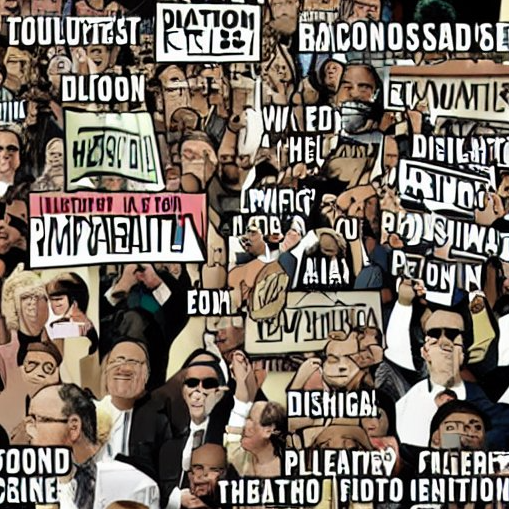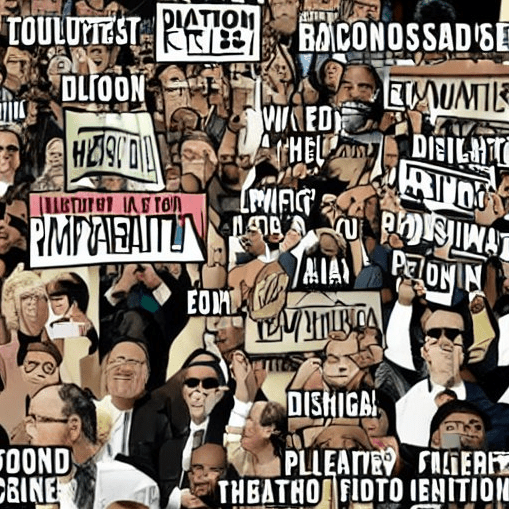A Cult Dictionary of Mind Control, and the Language of Abuse
Cultism has a long history here in the United States — but what is a cult, exactly? One could argue the Confederacy was a kind of cult, and the KKK after it. America gave rise to cult leaders Charles Manson, Jim Jones, David Koresh, and Sun Myung Moon, among many many others who led cults big and small (Charles Koch, perhaps?! Certainly Donald Trump.).
Christianity itself was considered a cult by some during its humble beginnings after the turn of the millennia and then some. It’s no accident that religious revivalism and many types of faith fervor colored the nation for decades and centuries. It’s the blind worship of a singular ideology or individual, in the case of a cult of personality, that is often the signature trait of both cult leaders and cult followers, who will do anything they’re told — even unto the grave.

Some might call the patriarchal nuclear family the Original Cult. Many if not most Evangelical sects revere it, among numerous others who believe in God the Father quite literally. Others still seek to exploit that zeal, by offering up a series of “flawed saviors” who dangled the prospect of a more theocratic state governed by Law and Order. Their money buys them much more than just the puppets who rule, and the citizens struggle to pierce the veils of illusion.
Mind control and emotional manipulation
Known by many names, from mind control to brainwashing to undue influence techniques, the use of methods to knowingly manipulate a target’s sense of reality is a devious and unethical way to achieve one’s aims with increased plausible deniability. Having obedient servants do your dirty work, bury your secrets, and protect your property perhaps is an archetypal dream of an America gone by… or current.
From schoolyard bullies and repressive religious upbringing to sexual predators and organized crime, the toolkit is eerily similar — it makes you wonder if they all get pamphlets in the mail from Head Evil, or if they instinctually all arrive at these methods on their own. Their goal is to get inside your head, destabilize you and keep you off balance, and gain some sort of advantage over you both currently and in ensuing negotiations, conflicts, or other events.


Today we are seeing it on a large scale in the digital domain, from Facebook radicalization and QAnon to right-wing backchannels and encrypted messaging. We had better get familiar with the lexicon and vocabulary of the coming era, so we can fight the creeping scourge of thought control roiling the land.
| Term | Definition | Notes | |
|---|---|---|---|
| abuse | Using one's position of authority unfairly and/or deceptively for personal gain. | https://doctorparadox.net/tag/emotional-abuse/ | Includes many forms, from emotional and psychological to financial, physical, narcissistic, and more. |
| aggression | Behavior intended to harm, injure, or assert dominance over another, either physically or psychologically. It's often characterized by hostility and, in some contexts, can be provoked or unprovoked. | https://doctorparadox.net/the-authoritarian-personality-craves-power/ | |
| anarchy | A political philosophy and social movement that rejects all forms of involuntary, coercive hierarchy and authority, advocating for a society organized without a government or governing body. | ||
| anti-government | An attitude or stance that opposes or is critical of the existing governmental structure, policies, or officials, often advocating for limited government intervention or reforms to current governance systems. | https://foundations.doctorparadox.net/Ideologies/anti-government | Examples: the Oath Keepers, Proud Boys, and other militia groups; the Sovereign Citizens Movement |
| anti-Semitism | Antisemitism is a form of discrimination, prejudice, bigotry, or hostility directed against Jewish people with a history dating back thousands of years. | https://foundations.doctorparadox.net/Dictionaries/Politics/antisemitism | Referred to as "the oldest hate," anti-Semitism is also inherently anti-feminist, because Jewish societies were once matrilineal. |
| apocalypticism | Preoccupation with the imminent end of the world. | https://doctorparadox.net/proteanism-vs-cultism-open-closed/ | see also: millenarianism |
| Armageddon | The apocalypse; the End Times; the end of the world as we know it (...and we feel fiiiiiiiine!) | https://doctorparadox.net/dictionaries/authoritarianism/end-times/ | also a movie with Bruce Willis, Liv Tyler, & Ben Affleck -- from back in 1998 when our apocalypsi seemed somehow more quaint |
| authoritarian | A personality type characterized by conventionalism, aggression, anti-intellectualism, superstition, paranoia, cynicism, destructiveness, projectivity, and a profound lack of imagination. | https://doctorparadox.net/essential-thinkers-on-authoritarian-personalities/ | |
| authority | Authority refers to the legitimate power or right to give orders, make decisions, and enforce obedience. It is typically associated with individuals or institutions that hold a recognized position within a social, political, or organizational structure. | ||
| beliefs | Beliefs are more like a kind of stock we own than a calculation we do on the fly. We spend time building them and deriving value from them.They're not simply tools for making good decisions, though, but are treasured in their own right and new information that challenges them is unwelcome. We often try to avoid it, in order to protect our beliefs. | https://doctorparadox.net/category/psychology/beliefs/ | |
| bias | Bias is a predisposition or inclination, often unreasoned, that leads to a subjective perspective or judgment in favor of or against a person, group, or thing. It can manifest in various forms, such as racial bias, gender bias, or confirmation bias. | https://doctorparadox.net/data-sets/psychological-biases-list/ | see also: motivated reasoning, bigotry, prejudice, revealed wisdom |
| bigotry | An unreasonable or irrational attachment to negative stereotypes and prejudices against a particular group, often manifesting in intolerance or hatred towards those of different races, religions, or sexual orientations. | https://doctorparadox.net/psychology/bigotry-is-bad-thinking/ | see also: hate crimes, genocide |
| boundary violations | Boundary violations occur when someone oversteps personal or professional limits, disrupting the expected or agreed-upon boundaries in a relationship or interaction. These can range from minor infractions to serious breaches, like in cases of harassment or abuse. | ||
| brainwashing | A process of forcibly and systematically altering an individual's beliefs, attitudes, and behaviors through psychological pressure, often in a controlled environment, stripping away previous identities and beliefs. | https://doctorparadox.net/dictionaries/hybrid-warfare/brainwashing/ | see also: mind control, thought control, undue influence |
| bribery | Bribery involves offering, giving, receiving, or soliciting something of value as a means to influence the actions of an individual in a position of power or authority, typically in a way that is illegal or unethical. | ||
| bullying | A form of aggressive behavior where an individual or group repeatedly and intentionally causes harm or discomfort to another person, often involving an imbalance of power. | https://doctorparadox.net/mental-self-defense/how-to-deal-with-bullies/ | |
| charisma school | Charisma schools are institutions or training programs that aim to teach individuals how to enhance their personal appeal and persuasive power, often focusing on communication skills, self-confidence, and leadership qualities. | Popular in PUA and "men's rights" communities | |
| child abuse | Any physical, emotional, sexual, or psychological maltreatment or neglect of a child by an adult, resulting in potential harm or risk to the child's health, survival, dignity, and development. | ||
| child brides | Young girls, typically under the age of 18, who are married off, often in cultures where early marriage is practiced, leading to issues like loss of education, health complications, and abuse. | ||
| child pornography | The creation, distribution, or possession of visual depictions of minors engaged in sexual acts or in sexually explicit poses, which is illegal and considered a severe form of child exploitation. | ||
| child trafficking | The illegal practice of procuring or trading children for various forms of exploitation, such as forced labor, sexual exploitation, or illegal adoptions. | ||
| cognitive dissonance | Cognitive dissonance occurs when an individual experiences mental discomfort or psychological stress due to holding contradictory beliefs, values, or attitudes, often leading to rationalization or attitude change. | https://doctorparadox.net/psychology/cognitive-dissonance/ | |
| con artist | A con artist is an individual who deceives others for personal gain, often through manipulation, fraud, or confidence tricks, typically involving financial or emotional exploitation. | Synonyms: swindler, scammer, trickster, deceiver, fraudster, charlatan, impostor, grifter, hoaxer, hustler | |
| conditional love | Conditional love is an affection or emotional attachment that is dependent on specific conditions being met, contrasting with unconditional love, which is given freely regardless of circumstances. | ||
| conspiracy theories | Explanations for events or situations that invoke a conspiracy by sinister and powerful actors, often politically motivated, when other explanations are more probable. They typically involve the belief that certain events or situations are the result of a secret plot by usually unseen and influential forces. | https://doctorparadox.net/why-do-people-believe-conspiracy-theories/ | |
| corruption | The abuse of entrusted power for private gain, often involving practices like bribery, embezzlement, or nepotism, and can occur in both public and private sectors. | https://doctorparadox.net/category/politics/corruption/ | |
| C-PTSD | Complex post-traumatic stress disorder -- a psychological condition occurring after exposure to trauma whether physical, emotional, or otherwise. | see also: PTSD | |
| CSAM | Child sexual abuse material | ||
| cult leaders | People who wield an alternating current of fear and "love" -- they swing a blunt instrument because they cannot manage the complexity of human relationships and real love. | https://doctorparadox.net/are-all-cult-leaders-narcissists/ | Many cult leaders are on the narcissism spectrum. |
| cult of personality | A cult of personality arises when a country's regime – or, more rarely, an individual – uses the techniques of mass media, propaganda, the big lie, spectacle, the arts, patriotism, and government-organized demonstrations and rallies to create an idealized, heroic, and worshipful image of a leader, often through unquestioning flattery and praise. A cult of personality is similar to apotheosis, except that it is created specifically for living leaders and not usually maintained after their death. | https://doctorparadox.net/dictionaries/american-fascism/cult/ | |
| dark money | Political spending by organizations that are not required to disclose their donors. Common in U.S. politics, it allows for significant financial influence while maintaining anonymity, often impacting elections and policy-making. | https://doctorparadox.net/dictionaries/authoritarianism/dark-money/ | |
| DARVO | DARVO stands for "Deny, Attack, and Reverse Victim and Offender." It's a reaction pattern by perpetrators of wrongdoing, particularly in cases of sexual misconduct, where they deny the behavior, attack the accuser, and present themselves as the victim. | https://doctorparadox.net/dictionaries/what-is-darvo/ | |
| deep fakes | Highly realistic and convincing digital manipulations of audio or video, often using artificial intelligence to alter or create content where someone appears to say or do something they did not. | https://doctorparadox.net/dictionaries/disinformation-dictionary/deep-fakes/ | |
| defense mechanism | An unconscious psychological strategy used to protect oneself from anxiety or distress, often by denying, distorting, or repressing reality. Common examples include denial, repression, and rationalization. | https://doctorparadox.net/psychology/defense-mechanism/ | |
| demagoguery | A political strategy where a leader appeals to popular desires, prejudices, and emotions rather than using rational argument, often through rhetoric and propaganda, to gain power or manipulate the public. | https://doctorparadox.net/people-data/demagogues/ | |
| denialism | Denialism involves the refusal to accept well-established facts, theories, or evidence, often in the context of historical events, science, or social issues. It's characterized by the rejection of expert consensus and the use of rhetorical tactics to give the appearance of legitimate debate. | https://doctorparadox.net/dictionaries/american-fascism/denial/ | |
| denying plain facts | Denying plain facts refers to the outright rejection or dismissal of clear, indisputable evidence or truths. This behavior is often rooted in cognitive biases, ideological beliefs, or a deliberate intention to mislead or deceive. | ||
| dissociation | Psychological dissociation is a mental process involving a disconnection from one's thoughts, identity, consciousness, or memory. It can occur as a coping mechanism during trauma, leading to a sense of detachment from the self or the external world, like a protective psychological escape from reality or intense stress. | https://doctorparadox.net/psychology/what-is-dissociation/ | |
| dogma | A rigid ideology or belief system | https://doctorparadox.net/mental-self-defense/freedom-from-dogma/ | A central lesson of science is that to understand complex issues (or even simple ones), we must try to free our minds of dogma and to guarantee the freedom to publish, to contradict, and to experiment. Arguments from authority are unacceptable. -- Carl Sagan |
| domestic violence | Domestic violence is a pattern of abusive behavior in any relationship used by one partner to gain or maintain control over another intimate partner. It can include physical, sexual, emotional, economic, or psychological actions or threats. | ||
| emotional abuse | A form of abuse characterized by a person subjecting or exposing another to behavior that may result in psychological trauma, such as anxiety, chronic depression, or post-traumatic stress disorder. It often involves manipulation, belittling, and controlling behavior. | https://doctorparadox.net/tag/emotional-abuse/ | |
| emotional blackmail | Emotional blackmail is a form of manipulation that uses guilt, fear, and obligation to control someone. It often involves threats and punishments, either directly or implied, to coerce the other person into doing what the manipulator wants. | https://doctorparadox.net/psychology/emotional-blackmail/ | |
| entitlement | Entitlement refers to the belief that one inherently deserves privileges or special treatment. It's a mindset in which an individual feels that they are owed something by society, life, or others, often without corresponding responsibility. | ||
| extortion | Extortion is the practice of obtaining something, especially money, through force or threats. It's a criminal offense which involves coercing a person or institution to hand over assets, services, or property. | ||
| extremism | Extremism involves holding extreme political or religious views and often advocating for radical or violent measures to support those views. Extremists often reject or undermine the norms and values of society in pursuit of their ideology. | https://doctorparadox.net/psychology/extremism/ | Now that sensible moderate conservatives have sensibly gone elsewhere, all that's left of the GOP is the terrifying extremism. |
| false memory implantation | False memory implantation refers to the psychological phenomenon where a person recalls memories that are factually incorrect but believed to be true. These memories can be implanted through suggestion or therapy techniques. | ||
| father figures | Men who provide guidance, support, and mentorship to someone, often in the absence of a biological father. They play a significant role in personal development, offering emotional, moral, and practical support. | Some people think of "freedom" as "freedom from" -- freedom from having to take responsibility for oneself, because one can take orders from a crusty old white dude who promises protection | |
| financial abuse | Financial abuse involves controlling a person's ability to acquire, use, and maintain financial resources. Often seen in domestic relationships, the abuser may withhold resources, hide information, or limit the victim's access to money, severely restricting their autonomy. | ||
| flying monkeys | A term derived from 'The Wizard of Oz', used in psychology to describe people who act on behalf of a narcissist to a third party, usually for an abusive purpose. They may spread lies, gossip, and carry out abuse by proxy. | https://doctorparadox.net/psychology/flying-monkeys/ | |
| front groups | Public-facing groups with innocuous and virtual-sounding names that exist only to recruit new members into the next circle of the organization, where the process of wearing down the independence of the target begins. | ||
| fundamentalism | A strict adherence to specific theological doctrines typically in a reaction against modernist theories, leading to a literal interpretation and strict adherence to basic principles of a religion or a religious branch. | https://doctorparadox.net/diptychs/the-artist-vs-the-fundamentalist/ | |
| gaslighting | Gaslighting is a form of psychological manipulation where a person or a group covertly sows seeds of doubt in a targeted individual, making them question their own memory, perception, or judgment, often evoking in them cognitive dissonance and other changes such as low self-esteem. | https://doctorparadox.net/mental-self-defense/gaslighting/ | |
| God complex | A God complex is an unshakable belief characterized by consistently inflated feelings of personal ability, privilege, or infallibility. A person with a God complex may refuse to admit the possibility of their error or failure, even in the face of complex or intractable problems. | ||
| grandiosity | An unrealistic sense of superiority, characterized by a sustained view of oneself as better than others that is often expressed as disdain or disregard for others' feelings. It is typically associated with narcissistic behavior, where an individual may exhibit exaggerated self-importance, need for admiration, and lack of empathy. | https://doctorparadox.net/psychology/grandiosity/ | |
| grift | Grift refers to the act of engaging in petty or small-scale swindling or fraud. It usually involves trickery or deception for personal gain, often in a charming or persuasive manner. | see also: con artist | |
| grooming | The process by which an offender draws a victim into a sexual relationship and maintains that relationship in secrecy. The grooming process is often very deliberate and involves manipulating the victim’s trust and isolating them. | see also: child abuse, child trafficking, human trafficking, sex trafficking | |
| groupthink | Groupthink occurs within a group of people in which the desire for harmony or conformity in the group results in an irrational or dysfunctional decision-making outcome. Group members try to minimize conflict and reach a consensus decision without critical evaluation of alternative viewpoints. | https://doctorparadox.net/models/bad-models/groupthink/ | |
| guilt | A cognitive or an emotional experience that occurs when a person believes or realizes—accurately or not—that they have compromised their own standards of conduct or have violated a universal moral standard and bear significant responsibility for that violation. | ||
| guru | A spiritual teacher, particularly in the Indian religions. In broader use, it's an expert or authority in a particular field, who seeks to guide others based on knowledge or wisdom they possess. | ||
| high demand groups | Organizations that often require extreme commitment and loyalty from their members. These groups can be religious, political, or social, and they typically demand a significant amount of time and energy from their members, often at the expense of personal relationships and independence. | https://doctorparadox.net/psychology/high-demand-groups/ | |
| human trafficking | Human trafficking is the trade of humans for the purpose of forced labor, sexual slavery, or commercial sexual exploitation for the trafficker or others. It is a serious crime and a grave violation of human rights. | ||
| hypnosis | A trance-like state in which a person has heightened focus and concentration. It is commonly used for therapy to recall memories or modify behaviors, often induced by a hypnotist using verbal repetition and mental images. | see also: Neural Linguistic Programming (NLP) | |
| ideology | A set of beliefs, values, and ideals that form the basis of a social, economic, or political philosophy or program. It can be a comprehensive vision, a way of looking at things, or a set of ideas proposed by the dominant class of a society to all members of this society. | https://foundations.doctorparadox.net/Ideologies/%E2%9C%B3%EF%B8%8F+Ideologies+Home | Has it slain coherence?! |
| influence techniques | Influence techniques are methods used to try to persuade or influence others' thinking, behavior, or perceptions. These can range from simple persuasion and negotiation tactics to more complex psychological strategies like manipulation and coercion. | https://doctorparadox.net/psychology/influence-techniques/ | |
| intermittent reinforcement | The same psychology behind casinos, intermittent reinforcement rewards the subject according to an irregular payout schedule that does not correspond to any of the actions of the subject. It is cognitively a very "sticky" mechanism -- one that has another common ancestor: addiction. | ||
| isolation | Isolation is the process or fact of isolating or being isolated, which can be physical, social, or emotional. It involves keeping a person away from others or limiting their access to external sources of information or interaction, often used as a tool for control in various contexts. | ||
| Kool-Aid | The phrase "drinking the Kool-Aid" is a colloquialism that has come to refer to a person or group holding an unquestioned belief, argument, or philosophy without critical examination. It originally referred to the 1978 Jonestown Massacre, where followers of Jim Jones drank a cyanide-laced drink as an act of revolutionary suicide. | ||
| labor exploitation | A situation where workers are not fairly compensated for their work, often involving poor working conditions, low wages, and long hours. It can include violations of labor laws and is often linked to practices like forced labor and child labor. | ||
| love bombing | A manipulative strategy used by individuals, often in the context of romantic or personal relationships as well as in cults, where excessive affection, attention, and flattery are used to influence or control another person. It is typically characterized by overwhelming displays of attention and affection, often early in the relationship, to gain trust and dependency. | https://doctorparadox.net/psychology/love-bombing/ | |
| magical thinking | The belief that one's thoughts, words, or actions can influence the course of events in the physical world in a manner not governed by the laws of physics or biology. This type of thinking is often characteristic of childhood development, but in adults, it can be a feature of various psychological conditions or a cultural belief system. | https://doctorparadox.net/psychology/magical-thinking/ | |
| malignant envy | A deep-seated resentment and anger towards another person’s possessions, qualities, or luck, often leading to a desire to harm or undermine the envied person. It's a destructive and pathological form of envy. | https://doctorparadox.net/dictionaries/authoritarianism/malignant-narcissism/ | see also: narcissism, NPD, malignant narcissism, Cluster B |
| manipulation | A skill or art of influencing or controlling someone to your advantage, often without their awareness. It involves using tactics like deception, misdirection, psychological tricks, and exploiting weaknesses to gain control or achieve a desired outcome. | ||
| mental predators | People who assume they have the right to abuse and manipulate others and use them for their own personal gain -- and behave accordingly. | https://doctorparadox.net/tactics-of-emotional-predators/ | see also: cult leaders, narcissism, sexual predators |
| mind control | A process in which an individual's thoughts, feelings, or actions are manipulated by another person or group. It often involves techniques that decrease the victim's ability to critically analyze or make independent decisions, leading them to adopt certain behaviors or beliefs. | see also: brainwashing, undue influence, mental predation | |
| minimizing | Minimizing is a psychological defense mechanism where a person downplays the significance of an event or emotion. It's often a way of reducing the impact of an action or thought that is perceived as threatening or harmful. | ||
| misogyny | Misogyny is the hatred of, contempt for, or prejudice against women. It manifests in various ways, including social exclusion, sex discrimination, hostility, patriarchy, male privilege, belittlement of women, violence against women, and sexual objectification. | https://foundations.doctorparadox.net/Dictionaries/Politics/misogyny | |
| mob rule | Mob rule refers to control by a mass of people, where decisions are made through the exertion of group dynamics rather than established legal procedures or democratic processes. It often suggests a chaotic, lawless situation controlled by a volatile, aggressive crowd. | ||
| moving the goalposts | A logical fallacy in which evidence presented in response to a specific claim is dismissed and some other (often greater) evidence is demanded. It's a way of changing the criteria of a debate or argument to exclude evidence that may oppose one's stance. | ||
| naive realism | The belief that we see reality as it really is – objective and without bias; that the facts are plain for all to see; that rational people will agree with us; and that those who don't are either uninformed, lazy, irrational, or biased. | ||
| narcissism | Narcissism is characterized by a grandiose sense of self-importance, a need for excessive attention and admiration, troubled relationships, and a lack of empathy for others. It's often centered around a person's inflated self-image and deep need for admiration. | https://doctorparadox.net/mental-self-defense/narcissism-and-cluster-b-personality-disorders/ | |
| narcissistic rage | Intense anger, aggression, or passive-aggression when a narcissist experiences a setback or disappointment, which threatens their sense of superiority and self-esteem. It's often disproportionate to the event that triggered it. | https://doctorparadox.net/psychology/narcissistic-rage/ | |
| narcissistic supply | Narcissistic supply refers to the attention, admiration, emotional energy, or other forms of "supply" that narcissists require and seek. It's a form of psychological dependence on others to fulfill their self-esteem needs. | https://doctorparadox.net/psychology/npd-narcissistic-personality-disorder/ | |
| negging | A manipulative behavior where a person makes a deliberate backhanded compliment or otherwise flirtatious remark to another person to undermine their confidence and increase their need for the manipulator's approval. | https://doctorparadox.net/psychology/negging/ | Often used in PUA and "men's rights" groups. |
| nihilism | The philosophical belief that life is without objective meaning, purpose, or intrinsic value. Moral nihilists assert that morality does not exist naturally, and that any established moral values are abstractly contrived. | ||
| organized crime | The mob and mob-like structures | ||
| paddling | A type of physical punishment, often delivered to children by strict or fundamentalist parents, in which a paddle is used to psychically strike the child -- often on the backside. | see: spanking | |
| paranoia | Extreme constant fear; conviction that others are "out to get you" | https://doctorparadox.net/psychology/paranoia/ | |
| patriarchy | A social system in which men hold primary power and predominate in roles of political leadership, moral authority, social privilege, and control of property. It often leads to the marginalization of women within these structures. | https://foundations.doctorparadox.net/Dictionaries/Politics/patriarchy | |
| phobia indoctrination | The process of teaching and ingraining irrational fears or hatreds towards certain groups, concepts, or ideologies. This often involves reinforcing negative stereotypes and fostering discriminatory attitudes. | https://doctorparadox.net/dictionaries/american-fascism/phobia-indoctrination/ | see also: bigotry, prejudice, racism, sexism, hate crimes, genocide |
| plausible deniability | A situation where a person can deny knowledge of or responsibility for any damnable actions committed by others in an organizational hierarchy because there is no clear evidence to prove involvement. It is often used in situations where it is beneficial to avoid direct blame or legal liability. | ||
| playing the victim | A manipulative behavior where a person portrays themselves as a victim of circumstances or the actions of others, typically to gain sympathy, justify their own behavior, or evade responsibility. It often involves exaggeration or fabrication of troubles. | ||
| police brutality | The use of excessive and/or unnecessary force by police officers against civilians. This can include physical violence, verbal attacks, psychological intimidation, and abuse of police powers. | a murdery version of the circle jerk | |
| post-truth | A political culture in which debate is framed largely by appeals to emotion disconnected from the details of policy, and by the repeated assertion of talking points to which factual rebuttals are ignored. It denotes situations where objective facts are less influential in shaping public opinion than appeals to emotion and personal belief. | post-truth scandals: Trump, Iran-Contra, Benghazi, Whitewater, Hillary's emails | |
| prejudice | A preconceived opinion that is not based on reason or actual experience. This bias, often negative, is directed towards people, groups, or concepts, and is typically founded on stereotypes. | https://foundations.doctorparadox.net/Dictionaries/Politics/prejudice | see also: bigotry, motivated reasoning |
| "proactive" violence | Violence committed as a deliberate strategy, often preemptive or anticipatory, rather than as a response to an immediate threat. It is used to achieve an agenda or exert control before any actual aggression has occurred. | ||
| projection | A psychological defense mechanism wherein individuals attribute their own unacceptable thoughts, feelings, or motives to another person. It is often a way of denying one's own negative traits by ascribing them to the external world. | https://doctorparadox.net/psychology/projection/ | |
| propaganda | Information, especially of a biased or misleading nature, used to promote a political cause or point of view. It is often characterized by its persuasive intent, aiming to influence the audience's beliefs or actions. | https://doctorparadox.net/dictionaries/authoritarianism/propaganda/ | see also: disinformation, fake news |
| prophecy | A prediction of future events, often based on divine or supernatural revelation. Prophecies are typically found in religious contexts and are seen as authoritative declarations of what will happen. | ||
| Prosperity Gospel | A religious belief among some Christian denominations that financial blessing and physical well-being are always the will of God for them, and that faith, positive speech, and donations will increase one's material wealth. It is often criticized for prioritizing material gain over spiritual values. | ||
| psychological abuse | A form of abuse characterized by a person subjecting or exposing another to behavior that may result in psychological trauma, including anxiety, chronic depression, or post-traumatic stress disorder. It includes emotional manipulation, intimidation, and persistent criticism. | ||
| psychological apocalypticism | The belief in an impending collapse of society or a cataclysmic event that will lead to drastic changes in the world order, often based on fear and anxiety. This mindset can drive extreme behaviors and ideologies, based on the perception of an imminent existential threat. | see also: phobia indoctrination, Armageddon, End Times, paranoia | |
| psychological warfare | The use of propaganda, threats, and other psychological techniques during war or conflict to influence an opponent's state of mind, undermine morale, and manipulate or deceive them. It aims to weaken the enemy's will to fight and resistance, without direct physical confrontation. | https://doctorparadox.net/category/politics/psychological-warfare/ | Employed heavily and optimized for the modern era by the Soviet KGB |
| psychopaths | Individuals who exhibit a long-term pattern of manipulating, exploiting, or violating the rights of others. This is often associated with an absence of empathy and remorse, bold, disinhibited, and egotistical traits. | https://doctorparadox.net/psychology/psychopaths/ | |
| PTSD | Post-traumatic stress disorder -- a psychological condition occurring after exposure to trauma whether physical, emotional, or otherwise. | ||
| purity | A concept often associated with an absence of contamination, pollution, or imperfection. In various contexts, it can refer to physical cleanliness, moral or ethical standards, or cultural or religious ideals of innocence and virtue. | ||
| racism | The belief that different races possess distinct characteristics, abilities, or qualities, especially so as to distinguish them as inferior or superior to one another. It also refers to prejudice, discrimination, or antagonism directed against someone of a different race based on the belief in racial superiority. | https://doctorparadox.net/category/psychology/racism/ | |
| radicalism | The beliefs or actions of individuals, groups, or organizations who advocate for thorough or complete political or social reform. It often involves the desire to transform or replace existing structures with new systems that are fundamentally different. | ||
| rape | A type of sexual assault usually involving sexual intercourse or other forms of sexual penetration carried out against a person without that person's consent. It is a serious crime and a grave violation of the victim's rights and dignity. | The second most serious violent crime after murder. | |
| rape culture | A sociological concept describing a setting in which rape is pervasive and normalized due to societal attitudes about gender and sexuality. Practices that contribute to rape culture include victim blaming, sexual objectification, and trivializing rape. | see also: misogyny, patriarchy, bigotry, prejudice, strict father morality | |
| re-education | Period of indoctrination when the recruit is taught the ideology of the cult as the One Truth; a process by which individuals are forced to abandon their previous beliefs or ways of thinking, often in a controlled environment, and to adopt new attitudes, often aligning with specific political or ideological agendas | ||
| religious abuse | The maltreatment of a person, often a child, in a religious context. This can include psychological manipulation, exploiting religious beliefs to exert control, and sometimes physical or sexual abuse under the guise of religious practice. | example: the notorious child sex abuse scandals of the Catholic church, the Mormon church, and the Evangelical church | |
| retcon | Short for "retroactive continuity," it's a literary device in which new information is introduced to a fictional narrative that alters the interpretation of previous events. It is commonly used in serial storytelling, like comics or television series -- as well as in disinformation campaigns and propaganda. | ||
| revealed wisdom | Knowledge or understanding considered to be divinely disclosed, often through sacred texts or spiritual experiences. This type of wisdom is often foundational to religious beliefs and practices. | ||
| sadism | The tendency to derive pleasure, especially sexual gratification, from inflicting pain, suffering, or humiliation on others. It can also refer more broadly to cruel behavior or attitudes. | ||
| scapegoating | The practice of unfairly blaming an individual or group for problems or negative occurrences, often as a way of distracting attention from the real causes or to satisfy the need to assign blame. It's a common tool in politics and social dynamics. | https://doctorparadox.net/psychology/scapegoating/ | |
| selective exposure | The tendency to favor information or media sources that confirm one’s beliefs and to avoid information that contradicts them. This behavior often leads to biased decision-making and a polarized understanding of issues. | ||
| sexual assault | Any type of sexual contact or behavior that occurs without the explicit consent of the recipient. This includes rape, but also encompasses a range of non-consensual sexual activities. | ||
| sexual predators | Individuals who seek out or engage in sexual activity with another person in a predatory and exploitative manner. They often use manipulative tactics or force to coerce their victims into sexual situations. | ||
| shame | A painful emotion caused by consciousness of guilt, shortcoming, or impropriety. Unlike guilt, which is a feeling of distress about one's actions, shame is often related to the self-perception of being seen negatively by others. | ||
| social dominance | A socio-political theory which suggests that societies are structured in hierarchical group systems, where one group has dominance over others. This dominance is maintained through a combination of power, social norms, and ideologies. | https://doctorparadox.net/psychology/social-dominance/ | |
| sociopaths | People with little to no empathy -- they can be very cold and cruel, yet also warm and charming. | ||
| sophistry | A method of argument that is seemingly plausible but actually fallacious and misleading. It involves using clever but unsound reasoning, often to deceive or persuade others. | ||
| spanking | A form of physical punishment involving the act of striking the buttocks of another person to cause physical pain, generally with an open hand. It is often used as a disciplinary measure for children. | Popular in a number of religious circles, usually fundamentalist sects. | |
| spare the rod | A phrase often interpreted as a justification for physical discipline in child-rearing. It suggests that failing to discipline children physically will lead to poor behavior and character development. | ||
| Special Mission | In a general sense, this term refers to a specific task or duty assigned to a person or group, often implying that it has a unique, important, or secretive nature. It's commonly used in military, diplomatic, or corporate contexts. | ||
| stonewalling | A refusal to communicate or cooperate, such as in a conversation or negotiation. This behavior involves shutting down dialogue, often as a power move or to avoid dealing with an issue. | ||
| supremacy | The state or condition of being superior to all others in authority, power, or status. It can refer to the dominance of one group, ideology, or social system over others. | https://doctorparadox.net/psychology/supremacy/ | |
| tax fraud | The illegal practice of deliberately falsifying information on a tax return to avoid paying the full tax obligation. Examples include underreporting income, inflating deductions or expenses, or hiding money in offshore accounts. | ||
| televangelist | A preacher who uses television broadcasts to spread their religious or moral messages, often appealing for financial support from viewers. Televangelists are typically associated with Christian evangelical movements. | ||
| thought reform | Also known as "brainwashing," it's the process of forcibly and systematically changing an individual's beliefs and attitudes, usually in a controlled environment. It often involves the breakdown of the individual's identity and beliefs, followed by the introduction of new beliefs. | see also: re-education, influence techniques, undue influence, brainwashing | |
| thought stoppers | Techniques or phrases used to halt or disrupt an individual’s critical thinking or analysis. These are often simplistic sayings or mantras designed to end an uncomfortable conversation or silence dissenting thoughts. | ||
| torture | Using physical violence during interrogation or to achieve compliance with a subject or recruit. | ||
| totalism | A practice or expression of a totalitarian system, which demands complete subservience to an authority or ideology. In a totalist system, individual needs and opinions are often suppressed for the perceived good of the group or the authority's agenda. | https://foundations.doctorparadox.net/Dictionaries/Politics/totalitarianism | |
| toxic positivity | The overgeneralization of a positive mindset, dismissing or invalidating genuine emotional experience. It involves the rejection of negative emotions and the insistence that individuals should maintain a positive attitude in all circumstances. | ||
| trauma bonding | The development of a strong emotional connection between a victim and an abuser, formed through a repeated cycle of abuse, devaluation, and positive reinforcement. It's often seen in abusive relationships and can make it difficult for victims to leave the situation. | ||
| undue influence | Excessive pressure or influence exerted by one person over another, which disrupts the victim's ability to make independent decisions. This can occur in various relationships, including legal, financial, and personal contexts. | ||
| verbal abuse | Pervasive and chronic denigration of the recruit or target, with the goal of diminishing her self-esteem and building up a dependence on the cult leader. | The use of words to cause harm to the person being spoken to. It involves the use of derogatory remarks, criticism, threats, and yelling, with the intent to intimidate, control, or demean the victim. | |
| victim blaming | The tendency to hold the victim of a crime or wrongdoing responsible for the harm that befell them. It involves suggesting that the victim's own actions or behaviors were the cause of their victimization. | see also: DARVO; Mudsill Theory | |
| white nationalism | White nationalists argue for policies that would establish or maintain a white majority in the country, often opposing immigration from non-European countries and advocating for policies that they believe would preserve white culture. | https://doctorparadox.net/save-democracy/right-wing-ideologies/white-nationalist-beliefs/ | |
| whitewashing | Trying to clean up the reputation of someone or something after the fact -- attempts to rehabilitate a famous person following crime, for example. |



















































